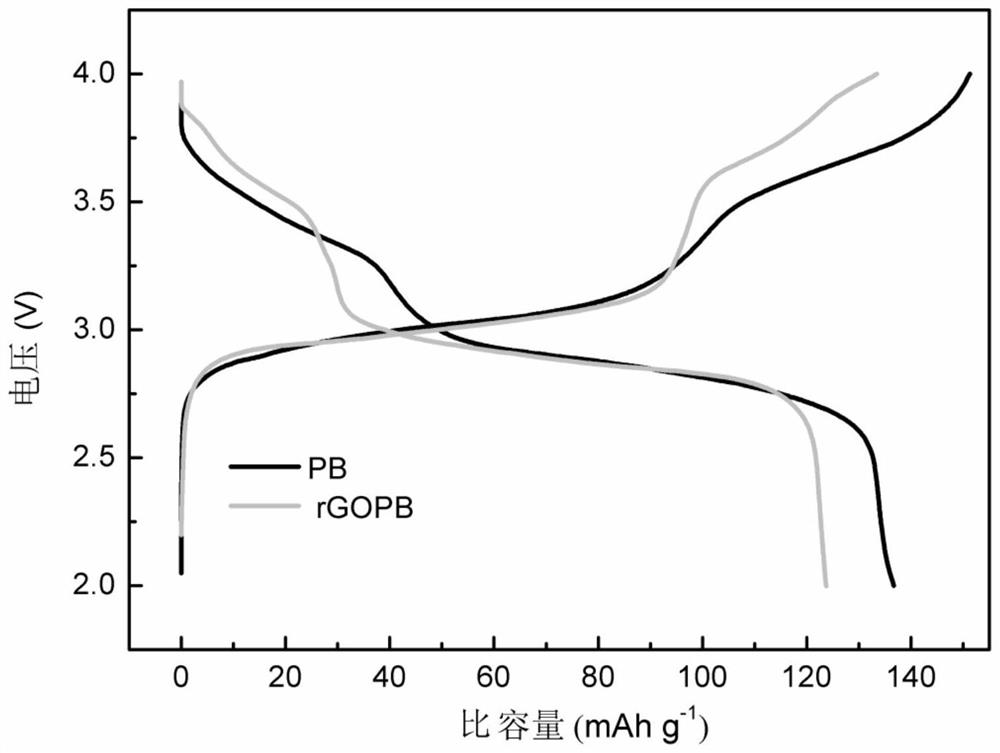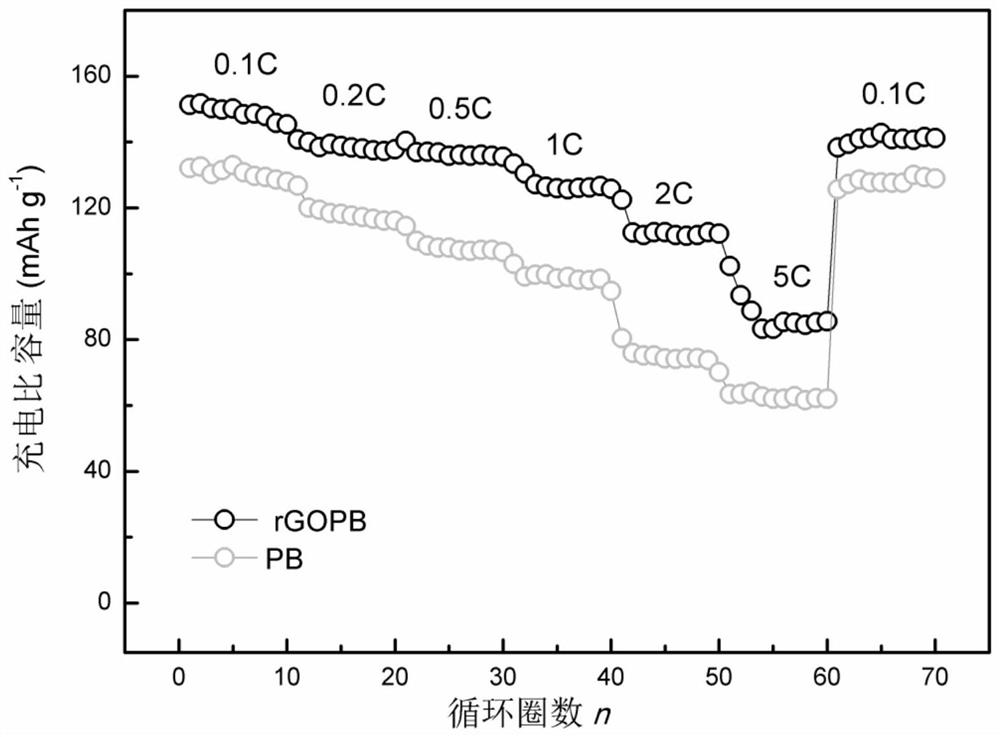Preparation method and application of a composite reduced graphene oxide Prussian blue material
A technology of Prussian blue and graphene, applied in the field of preparation of Prussian blue materials, can solve the problems of low specific capacity, high method cost, complicated operation, etc.
- Summary
- Abstract
- Description
- Claims
- Application Information
AI Technical Summary
Problems solved by technology
Method used
Image
Examples
Embodiment 1
[0048] The preparation method of the Prussian blue material of composite reduced graphene oxide adopts the following steps:
[0049] 1) Prepare 200ml of Na with a concentration of 10mM 4 Fe(CN) 6 Solution A, transfer it to a beaker with a magnet, and stir with a magnetic stirrer at a low speed of 300rpm. 2) Using commercially available graphene oxide GO, according to relative Na 4 Fe(CN) 6 The mass ratio of 2% was weighed and added to solution A, ultrasonicated for 10 minutes to make it uniformly dispersed to obtain solution B.
[0050] 3) Add ascorbic acid and 1 mM sodium citrate to the solution B so that the final concentration is 1 mM, and stir for 5 min to obtain a mixed solution C.
[0051] 4) Use a pH tester to measure the pH value of solution C in real time, and add hydrochloric acid dropwise to pH = 1 to obtain solution D.
[0052] 5) Transfer the above solution D to a flask and fix it in a water bath, pass an inert gas such as nitrogen, and place it in the dark, ...
Embodiment 2
[0061] The preparation method of the Prussian blue material of composite reduced graphene oxide comprises the steps:
[0062] 1) Prepare 200ml of Na with a concentration of 20mM 4 Fe(CN) 6 Solution A, transfer it to a beaker with a magnet, and stir with a magnetic stirrer at a low speed.
[0063] 2) Pre-prepared graphene oxide GO by Hummers method, according to relative Na 4 Fe(CN) 6 The mass ratio of 5% was weighed and added to solution A, and it was ultrasonically dispersed for 15 minutes to obtain solution B evenly.
[0064] 3) Add ascorbic acid and sodium citrate to solution B to make the final concentration of each 2.5mM, stir for 8min to obtain mixed solution C.
[0065] 4) Use a pH tester to test the pH value of solution C in real time, add hydrochloric acid dropwise to pH = 1.2, and obtain solution D.
[0066] 5) Transfer the above solution D to a flask and fix it in a water bath, pass an inert gas such as nitrogen or hydrogen-argon mixed gas, keep it away from li...
Embodiment 3
[0072] The preparation method of the Prussian blue material of composite reduced graphene oxide comprises the steps:
[0073] 1) Prepare 200ml of Na with a concentration of 30mM 4 Fe(CN) 6 Solution A, transfer it to a beaker with a magnet, and stir with a magnetic stirrer at a low speed.
[0074] 2) Pre-prepared graphene oxide GO by Hummers method, according to relative Na 4 Fe(CN) 6 The mass ratio of 10% was weighed and added to solution A, ultrasonicated for 30 minutes to make it uniformly dispersed to obtain solution B.
[0075] 3) Add ascorbic acid and 5 mM sodium citrate to solution B with a final concentration of 5 mM, and stir for 10 min to obtain mixed solution C.
[0076] 4) Use a pH tester to test the pH value of solution C in real time, and add hydrochloric acid dropwise to pH=2 to obtain solution D.
[0077] 5) Transfer the above solution D to a flask and fix it in a water bath, pass through an inert gas such as nitrogen or hydrogen-argon gas mixture, keep it ...
PUM
| Property | Measurement | Unit |
|---|---|---|
| particle diameter | aaaaa | aaaaa |
Abstract
Description
Claims
Application Information
 Login to View More
Login to View More - R&D
- Intellectual Property
- Life Sciences
- Materials
- Tech Scout
- Unparalleled Data Quality
- Higher Quality Content
- 60% Fewer Hallucinations
Browse by: Latest US Patents, China's latest patents, Technical Efficacy Thesaurus, Application Domain, Technology Topic, Popular Technical Reports.
© 2025 PatSnap. All rights reserved.Legal|Privacy policy|Modern Slavery Act Transparency Statement|Sitemap|About US| Contact US: help@patsnap.com



